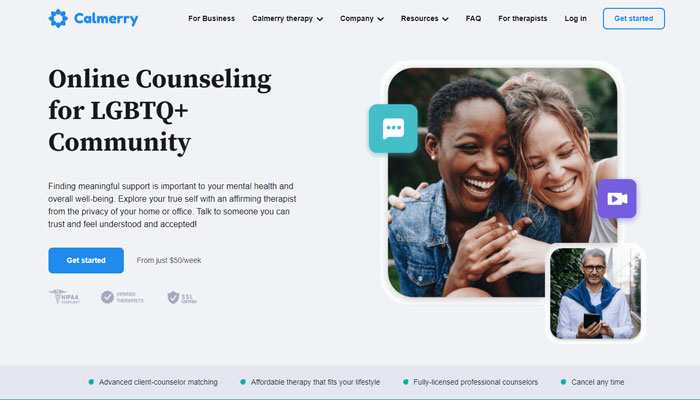Nonbinary Gender Dysphoria — Everything You Need To Know.

Recently, there’s been a wide awareness call to recognize genders outside the orthodox gender identity, and such gender is referred to as non-binary.
What is non binary?
Non binary is an umbrella term for describing people who are neither exclusively male nor female and outside the traditional gender category.
Non-binary also call themselves enby. The umbrella term covers other gender expressions and identities such as genderqueer, gender outlaw, agender, and transgender.
✔️ Feeling very confused?
Here at ANZPath, we highly recommend talking to a gender dysphoria therapist and Calmerry have some of the best available.
It’ll help give you peace of mind.
Talk to a gender dysphoria therapist within 24 hours by filling out the questionnaire at Calmerry.com.

What is non binary gender dysphoria?
Non binary gender dysphoria describes the despair and distress non-binary people experience because of the difference between their gender identity and the sex assigned to them at birth.
Non-binary gender dysphoria is prevalent, most especially among people who are not allowed to express their gender identity freely.
For instance, a non-binary person whose parents treat them like a female may experience gender dysphoria, which can negatively affect his mental and general well-being.
An openly non-binary may also experience gender dysphoria if such a person stays in a community that discriminates against them.
A person who is not open will experience gender dysphoria in the long term because of the burden of hiding their gender identity because of fear of prejudice, rejection, and isolation.
The onset of gender dysphoria in nonbinary individuals usually starts at a young age and peaks around puberty when they become sexually mature.
Signs of non binary gender dysphoria
The traditional criteria of DSM-5 may not include nonbinary people since the DSM-5 defines gender dysphoria as wanting to be an opposite gender and nonbinary do not which to be the opposite or alternative gender.
Common symptoms of non-binary gender dysphoria are:
- Aversion for specific gender signifiers. For example, a person may dislike a particular body part but love another part.
- A strong desire to defend their chosen gender identity.
- Feeling pressured to embrace multiple gender roles, especially conflicting gender identities.
- Social isolation from peer
Non-binary gender dysphoria— A mental disorder or illness
Gender dysphoria is no longer listed as a disorder in the DSM-5, though it can contribute to the onset of other mental diseases and conditions. Gender dysphoria can lead to anxiety, depression, eating disorders, and substance abuse.
However, psychologists may refer to gender dysphoria as a gender identity disorder, which does not make non-binary gender dysphoria a mental illness.
How to deal with non binary dysphoria. Treatment.
There are several ways of how to deal with non binary dysphoria. Treatment of this condition is personalized as individual needs, and goals vary.
Treatment of gender dysphoria allows individuals to explore gender identities that they feel comfortable with. Conversely, it will help individuals reduce and overcome the distress associated with gender dysphoria.
Treatment options are usually a combination of medical and non-medical treatment options. Treatment options include;
- Gender expression
- Pharmacological treatment,
- Gender affirmation surgery
- Counseling
- Gender expression
The individual is given the room to express their preferred gender identity. It may involve a change of name, gender on official documents, and dressing in a manner that matches their gender preference.
- Pharmacological Treatment
Gender-affirming hormones alter physical appearance to match the preferred gender identity.
However, nonbinary people do not need gender-affirming hormones to be who they want to be. Masculinizing hormone ( testosterone) and feminizing hormone are used by trans men and women, respectively, and nonbinary people.
- Gender reassignment surgery
These are procedures that enable people to transition to their self-identified gender. The surgery could be facial surgery, top surgery, or bottom surgery.
- Counseling
Non-binary people with gender dysphoria will benefit from counseling. Counseling can help you cope with confusion, fear of judgment, isolation, and stress. All of these can harm your mental health if not addressed.
Talking to a therapist here is one of the best ways to maintain your mental health and well-being. Counseling can also be used to support other treatments mentioned above.
Research shows that non-binary and transgender who undergoes counseling along with other treatment plans have no problem during the transition.
Other treatment options include
- Puberty blockers
- Voice therapy
Dealing with nonbinary gender dysphoria
Coping with gender dysphoria can be challenging in an unsupportive environment.
However, you can relieve the distress of gender dysphoria by doing the following;
- Join a peer support group.
- Talk to someone who understands what you’re going through here.
- Avoid people or situations that will trigger.
- Constantly affirm your gender with positive affirmations.
- Prioritize self-care and mental wellbeing
- Identify the root of your gender dysphoria and learn how to cope.
- Make transition goals and plans.
Transgender Body Dysmorphia
Some transgender people experience body dysmorphia along with body dysphoria. Both terms are often confused with one another, even though they are entirely different.
Transgender body dysmorphia is the dissatisfaction felt by transgender people with their body, believing that their body and outer appearance is deeply flawed. Body dysmorphia is currently included in the Diagnostics Statistical Manual 5 DSM —5 as an anxiety disorder.
Affected individuals by transgender body dysmorphia have a distorted view of themselves which is usually accompanied by an intense feeling of shame about one’s body and overall physical appearance.
Relationship Between Non-binary Gender Dysphoria and Transgender Body Dysmorphia
It has been established that non-binary gender dysphoria and transgender body dysmorphia are different, but they are not always mutually exclusive.
Transgender and non-binary people can experience the two at the same time. Transgender and non-binary people with both conditions feel insecure, uncomfortable, and distressed about their gender, size, and shape.
The combination of these can lead to an eating disorder which is an attempt to control the perceived flaws in their body and gender identity by eating more or less than necessary.
Difference Between Body Dysmorphia and Gender Dysphoria
Gender dysphoria responds to treatment, while body dysmorphia doesn’t respond to treatments even when such changes involve the physical transformation of the body.
Treating transgender body dysmorphia includes extensive cognitive behavioral therapy, which encourages individuals to challenge their thought processes.
Conclusion
Non-binary gender dysphoria is neither a mental illness nor a disorder. It is the distress felt by people whose gender identity differs from the sex assigned to them at birth.
